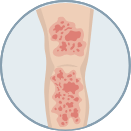Affecting the thin membrane protecting several of the body’s most important organs, including the lungs, abdomen and heart, peritoneal mesothelioma is a rare form of cancer that develops in the lining of the abdomen, known as the peritoneum. The peritoneum is a thin serous membrane that protects and supports the organs in the abdomen. It is made up of an outer layer (parietal peritoneum), which is attached to the abdominal wall, and an inner layer (visceral peritoneum), which covers the internal organs. A small space between the two layers contains fluid that allows for movement of organs within the abdomen as they function normally.

Peritoneal Mesothelioma Causes
Peritoneal mesothelioma is a rare form of cancer and affects the lining of the abdomen when ingestion of microscopic asbestos fibers become embedded in the peritoneum. While it is known that asbestos causes peritoneal mesothelioma, it is unclear how the asbestos fibers reach the peritoneum. This may occur when asbestos fibers are ingested and travel through the intestinal system to the peritoneum. It is also possible that the fibers are inhaled and carried through the lymphatic system. In some cases, mesothelioma found in the peritoneum originated as pleural mesothelioma and spread to the peritoneum.
As these fibers reside in the peritoneum, they can cause irritation that may eventually lead to inflammation and a buildup in the membrane’s fluid. Cells in the peritoneum then may also become abnormal and divide out of control. Tumors growing in the peritoneum, as well as the fluid buildup, then put pressure on the organs in the abdominal cavity.
The Only Known Cause of Peritoneal Mesothelioma is Exposure to Asbestos
Common Industries

Military

Mechanics

Shipyards

Construction

Manufacturing

Factories
Various Materials & Products

Flooring, Walls, Insulation

Roof, Siding, Windows

Secondhand

Powder

Plumbing

Pottery & Ceramics
Used for decades in a variety of different industries and products, many people, knowingly or unknowingly, may have been exposed to asbestos in their workplace, home or school. Secondary exposure may be possible from contact with someone exposed to asbestos in which these fibers may have traveled with them on clothing or work equipment.
Peritoneal Mesothelioma Symptoms
Symptoms of malignant peritoneal mesothelioma can take 10 to 60 years or more after initial asbestos exposure to exhibit symptoms. Once symptoms develop, they are often similar to those of common abdominal ailments or discomfort, which makes this cancer difficult to detect. In addition, symptoms typically do not appear until the cancer has progressed to a more advanced stage.
Peritoneal mesothelioma symptoms are often caused by the buildup of fluid in the abdominal cavity (ascites) and the thickening of the lining of the abdomen (peritoneal thickening). The more advanced a patient’s mesothelioma is, the more pressure ascites and peritoneal thickening put on the internal organs in the abdominal cavity.
Individuals with peritoneal mesothelioma may also experience:

Ascites

Abdomen Pain or Swelling

Unexplained Weight Loss

Obstruction of Small or Large Intestine

Buildup of Gas

Fever

Anemia

Legs Swelling or Thrombosis







